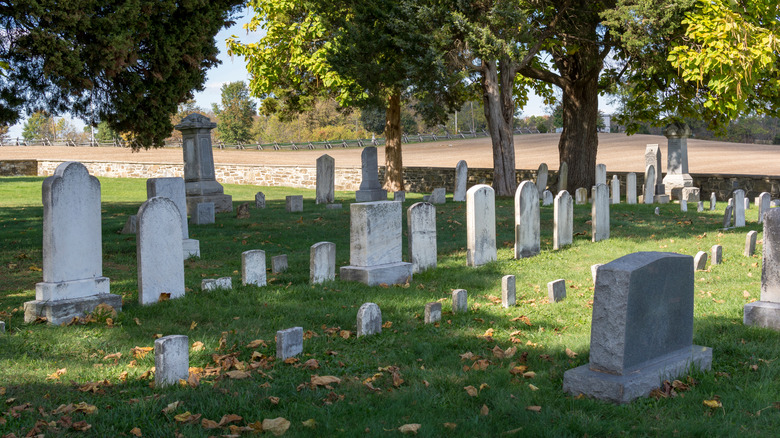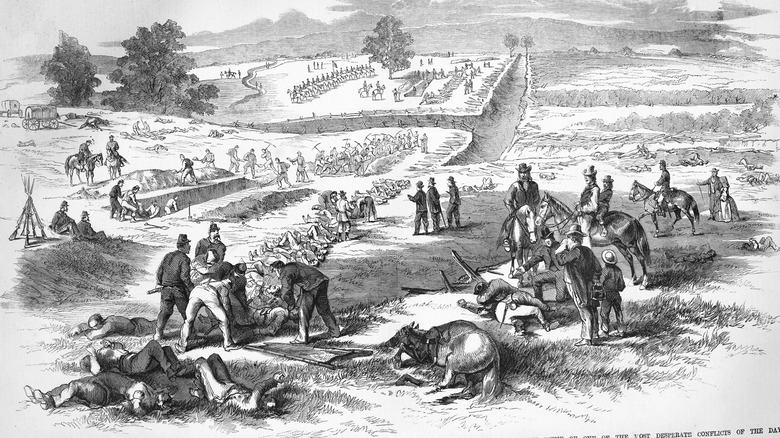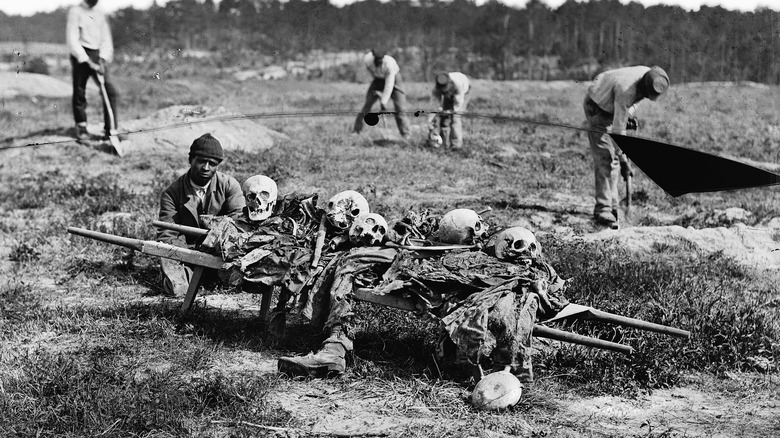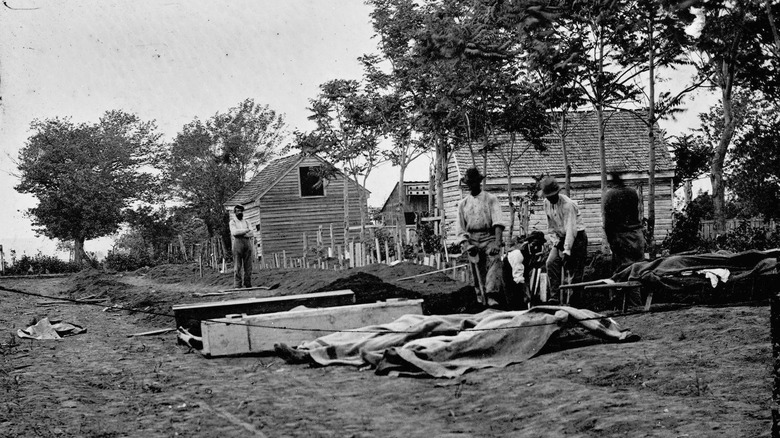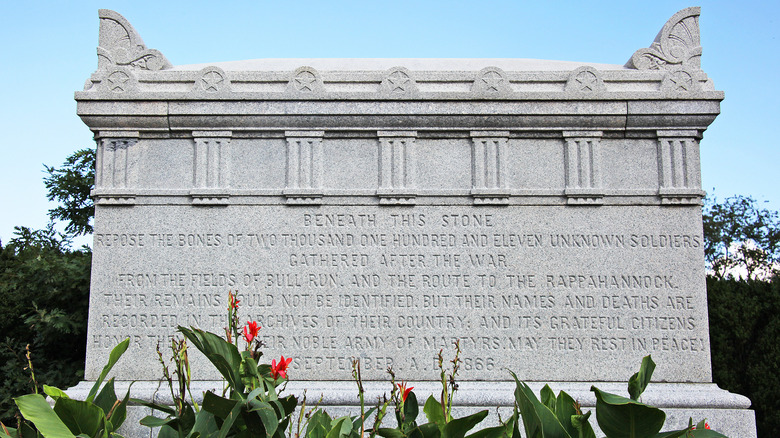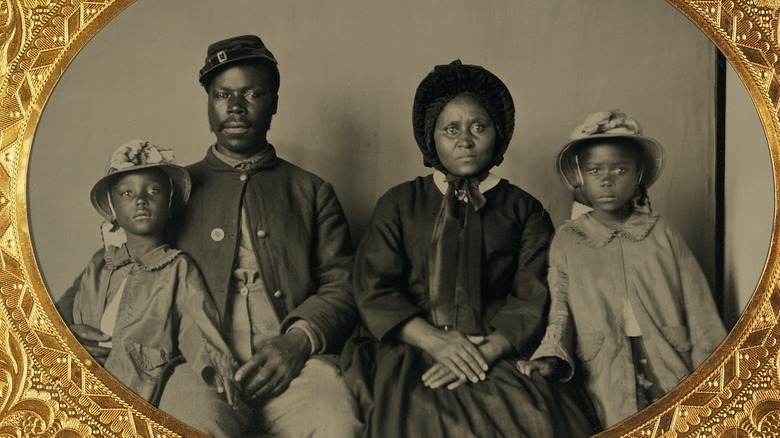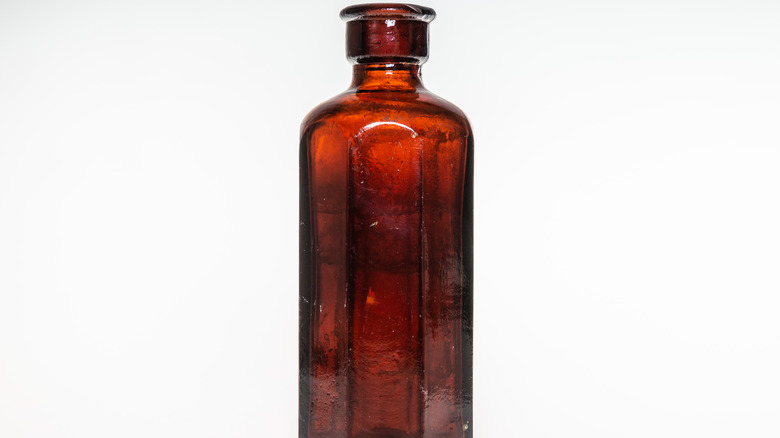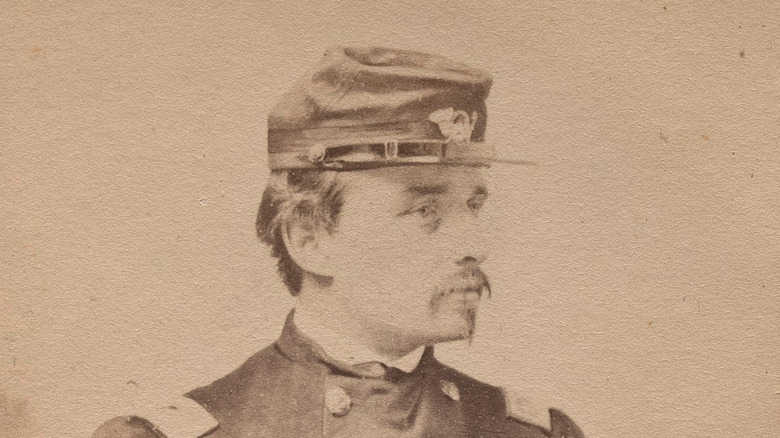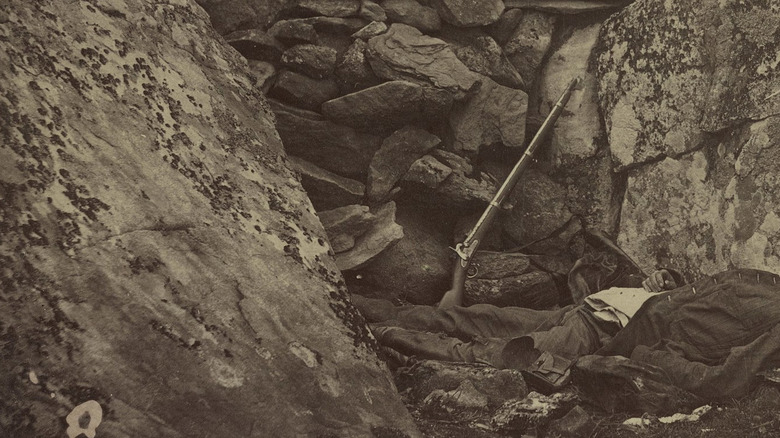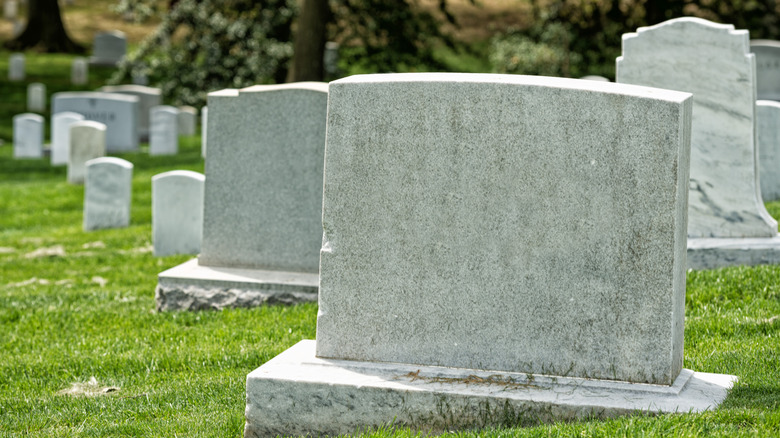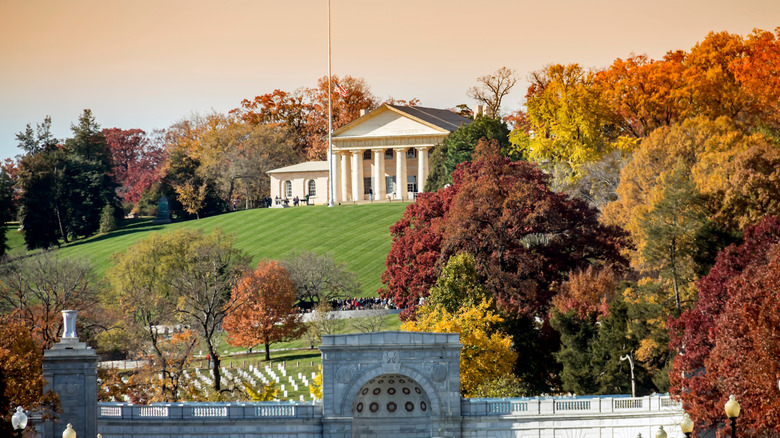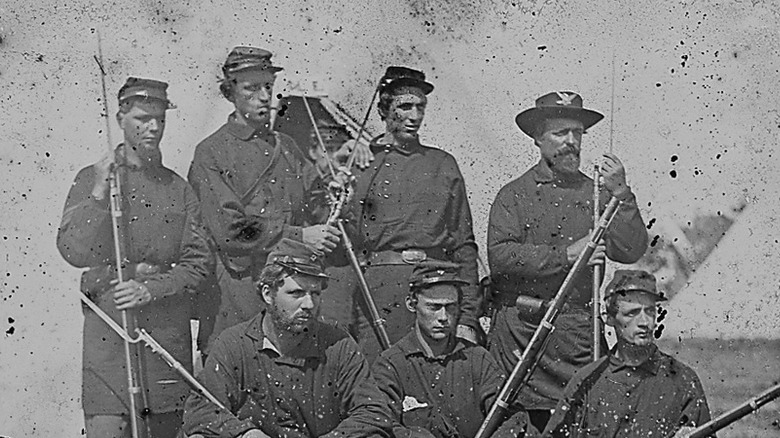What Happened To The Bodies Of Civil War Soldiers Who Died In Battle?
The American Civil War contained many atrocities, including the mistreatment of free and enslaved Black Americans, as well as the devastation of Union General William Tecumseh Sherman's vengeful 1864 march through Georgia. As a U.S. citizen at the time, it was difficult in the extreme to avoid some of the effects of the war. Even the most sheltered people would be faced with newspaper reports and, eventually, unsparing photographs of the destruction.
But the starkest and most gruesome outcome of one of the deadliest wars in history was the overwhelming number of bodies. After a battle, places in both the Union and Confederacy could be littered with so many corpses that getting them all buried likely felt impossible. With no organized way to collect and inter the dead, many remains were hastily consigned to mass graves with little hope of identification. Others didn't even get that small dignity, as some bodies were left to disintegrate in the open and turn into scattered bones.
Yet, some of the dead benefited from cutting-edge technology of the time, including embalming techniques that allowed remains to make it back to grieving families across the country. Others became the subjects of famous photographs. Meanwhile, dogged investigators proved that not all of the dead would remain nameless, even in the wake of a traumatic war. Here's what happened to the bodies of Civil War soldiers who died in battle.
The number of dead could be overwhelming
Of all the wars in which the United States has taken part, the American Civil War by far was the bloodiest. Over just four years from 1861 to 1865, hundreds of thousands of lives were lost. For a while, the common estimate held that about 620,000 soldiers died on both sides combined. But the reality may have been even worse. A more recent analysis of historic records published in the journal Civil War History indicates that many more soldiers perished, with an estimated death toll of 750,000 more likely and perhaps even as many as 850,000. The confusion in which 100,000 or more service members may have been forgotten is due largely to poor record keeping during and after the oftentimes chaotic war. No matter the exact number, it's clear that this was a conflict that left survivors across the broken nation reeling at the sheer loss and waste of human life.
Those who were present to observe the shocking numbers of the dead on battlefields like those at Bull Run or Shiloh would have been directly confronted by the gruesome reality of war. In a single day of fighting at Antietam, some 23,000 soldiers were killed. But that wasn't even close to the worst battles of the Civil War. That very dubious honor goes to the Battle of Gettysburg, which saw the deaths of an estimated 51,000 over a mere three days in July 1863.
Dead soldiers could stay where they fell for a long time
The sudden deaths of masses of people on Civil War battlefields proved to be overwhelming both emotionally and logistically. In an era before telecommunications or even electricity, how were people supposed to coordinate the removal of the dead? The truth was that many simply didn't. Though hastily assembled groups of soldiers and civilians eventually stepped in to manage the task, it rarely happened efficiently. Observers of the aftermath of the Battle of Antietam noted that it took more than a week for burials to commence. With no dedicated group of graves personnel, no ambulance service, and no military policy to identify the deceased, confusion reigned.
Antietam was not necessarily the worst of it. While some remains were at least collected and hauled into mass graves, others were left in the open indefinitely. This was more likely if the dead were from the opposing side and had died in enemy territory. Still, when troops moved back over battlefields a year or more later to encounter skeletons in places like Bull Run or Chancellorsville, little was often left to identify whether the deceased fought for the Union or the Confederacy.
Many soldiers were hastily buried and forgotten
For the people who did take it upon themselves to bury the dead, it wasn't possible to give every single body an individual grave. Soldiers might go to the extra effort if they knew the deceased or if there was enough time. But with so many remains and sometimes sweltering weather that only encouraged faster decomposition, mass graves were the only real answer. This was especially so if the dead were from the enemy side, as soldiers on burial detail weren't expected to take extra care of those remains.
Witnesses to mass graves typically explained that soldiers would dig long trenches and carry or drag bodies to the hole, sometimes placing them in alternating directions to save space. Because the bodies were often decomposing at that point, those on burial detail typically dragged the remains, using blankets or ropes to transport the dead.
As for grave markers, some served their purpose to delineate a burial spot. Others disintegrated or were never put there in the first place, leaving some mass graves forgotten for well over a century. Writing for The Washington Post, metal detectorist Kevin Ambrose reports that he helped uncover a Civil War-era grave in Centreville, Virginia. A full excavation began in 1994, revealing the remains of six Union soldiers who had been lying there for well over a century. They were all identified and returned to their hometowns to be buried.
Identifying the dead was difficult
In the Civil War, there was no common identification carried by soldiers, unlike the standard-issue metal dog tags of later conflicts. Especially motivated people might go through a soldier's pockets to look for anything that might offer up a name, but that was hardly a given. That, plus inconsistent record keeping, meant that the living were sometimes listed as dead, and vice versa. Using mass graves further complicated things, as few on burial detail took the time to do more than place a marker estimating the number of the bodies buried. By some estimates, more than half of the dead were never connected to a name at all.
Perhaps most heartbreaking of all was the sight of families wandering battlefields, looking for a familiar face amongst the dead. For much of the war, General Ulysses Grant typically allowed civilians to move through battlefields so long as they didn't get in the way of the military.
Modern archaeologists also struggled to identify the dead after the fact. The six Union soldiers buried near Centreville, Virginia uncovered in the mid-1990s had been placed in coffins in their uniforms. But they didn't carry any identification, and researchers had to use historic documents and forensic analysis of the remains to connect them with lost soldiers from the 1st Massachusetts Infantry. (DNA analysis was difficult to access and highly expensive at this time.)
[Featured image by Tim1965 via Wikimedia Commons | Cropped and scaled | CC BY-SA 3.0]
Families may or may not have been notified
Families of Civil War soldiers sometimes found themselves in terrible limbo. With a son, brother, or father who went off to war, and with so much news of battlefields covered in corpses, it may have seemed that their loved ones were among the dead.
Some at least got word of their loved one's fate, though it wasn't guaranteed and letters sometimes arrived long after a soldier's death. That's in large part because there was no official or organized way of identifying remains, much less one to notify families. Some dying soldiers managed to write their own letters home, while fellow service members might take it upon themselves to contact a comrade's family. But not everyone was so lucky, as the many anonymous battlefield graves make painfully clear.
However, not everyone was so overwhelmed or careless that identifications couldn't be made. Shortly after the war, famed nurse Clara Barton set up the Missing Soldiers Office, which helped to identify over 20,000 men. Barton used her own money to keep the enterprise going, answering thousands of inquiries and poring over records with a small team. The office also managed to publicize a regular "Roll of Missing Men" that put thousands of names of disappeared soldiers onto posters and in newspapers across the country. Ex-inmates of prison camps also proved invaluable to Barton's effort, which helped families receive closure and benefit from the deceased's pension.
Some remains were embalmed
Though many soldiers' remains were loaded into graves with little hope of later identification, towards the end of the war, the new art of embalming offered an alternative. Before this, funerals and burials were often rushed affairs, even if there wasn't a war going on. Though mourning and remembrance continued in many ways after a grave was closed, families first had to bury the remains of loved ones before decomposition made itself too obvious. But what to do about someone who died on a battlefield far from home? Families who were able to learn of a loved one's death sometimes requested that their remains be shipped back to them, but a lack of consistent refrigeration made this a gruesome affair.
The answer was to re-engage with a fringe practice: embalming. Like so many other practices around death and dying in the Civil War, however, preserving corpses was a haphazard and quasi-professional process. Early attempts involved replacing a body's fluids with arsenic and mercury solutions. Despite the less than consistent results, enough people asked for embalming that the government began requiring licenses for embalmers — perhaps a welcome change, as earlier, less-professional embalmers rather ghoulishly set up shop alongside battlefields and even encouraged soldiers to pay for the process ahead of their deaths.
Social differences remained even in death
Even though death seems like the great leveler, the remains of Civil War soldiers were still often treated differently based on race and class. Given that embalming bodies and transporting them back home was an expensive proposition, it was often reserved for fallen officers with more money.
Writer and father of Union soldier Oliver Wendell Holmes noted in "Death and the Civil War" (via Humanities) that officers' remains were more likely to come home embalmed and in caskets. The lower-class dead were typically found in graves dug closer to where they fell. Some Union officers' remains were even put to rest in the garden of Confederate General Robert E. Lee's wife.
Race also divided Black and white soldiers, even after death. When they were buried in cemeteries, Black troops were typically consigned to segregated sections, including at Arlington National Cemetery. On the battlefield, burials didn't always play out this way, though. Colonel Robert Gould Shaw, the white commander of a Black regiment, was buried in a mass grave with his troops after they were killed during a July 18, 1863 attack. Confederates meant it as an insult, but Shaw's abolitionist family took it as an honor and requested that his remains stay where they had been originally buried. This segregated burial practice continued until President Harry S. Truman ordered the integration of the military in 1948.
[Featured image by National Portrait Gallery via Wikimedia Commons | Cropped and scaled | CC 1.0]
Some became the subject of famous photographs
Though photography had already been around for decades, war photographers were still a new sight for many observers. These weren't simple point-and-shoot cameras, either, but complex affairs with lots of equipment. Yet photographers like Alexander Gardner, Timothy H. O'Sullivan, and Matthew Brady took their darkroom wagons to battlefields anyway, wanting to document the horrors of war in a way sketches and reports never could, while also gaining fame and commercial success.
Gardner proved to be an especially complicated figure in this new field. After gaining attention for his photographs of the aftermath of Antietam, Gardner made his way to document the human wreckage of Gettysburg. Once there, he took a photo he later said was of a fallen Confederate sniper on a rocky outcrop, naming it "Home of a Rebel Sharpshooter." It was eventually accompanied by dramatic text written by Gardner that pointed out details such as the blanket where the rebel had laid down to die.
But Gardner was almost certainly lying. The truth was, on the battlefield, he had probably taken the remains of a Confederate infantryman he'd already photographed and moved it to that picturesque outcrop, according to historian William Frassanito's analysis in "Gettysburg: A Journey in Time" (via Library of Congress). The scene was made complete with a rifle Gardner used as a regular prop, and which almost certainly would not have been used by a sniper.
National cemeteries marked a turning point in how military remains were honored
As the growing number of dead presented a stark reminder of the costs of war, it became increasingly obvious that some sort of change was needed. For many, it was unacceptable that so many of the dead would have lost their lives with no honor to their names. Of course, this was easier to accomplish once the war was over.
Confederate General Robert E. Lee surrendered to Union General Ulysses S. Grant at Virginia's Appomattox Courthouse on April 9, 1865, marking the end of the conflict (though one more battle was fought in Texas a month later). That fall, Quartermaster General Montgomery C. Meigs ordered soldiers to begin searching out Union graves to identify and protect the resting places of the dead. It turned into a six-year effort that included the reburial of more than 300,000 Union soldiers, though little more than half were identified. Nameless or not, many of the dead were bound for one of 74 new national cemeteries established by the federal government. It was just as well for those who had been buried in former Confederate territory, as many in the South were not prepared to respect the graves of the Yankees, whom many still opposed.
Some Union dead were buried at Robert E. Lee's estate
Today, Arlington National Cemetery is a peaceful, solemn place. But it was once a sprawling estate belonging to Mary Custis Lee, wife of Confederate commander Robert E. Lee. The Union quickly seized it at the beginning of the war, though the Lee family continued battling for control decades later.
Few on the Union side were sympathetic to the Lees, however. Quartermaster General Montgomery C. Meigs thought it was only right that Lee should lose the property, and perhaps his life, too. No one went quite so far as to execute Lee or any other top Confederates, but Montgomery Meigs saw to it that Arlington would serve a more useful purpose than hosting high-class soirees or well-mannered strolls about the grounds. Part of the estate became home to an estimated 1,500 formerly enslaved people, who constructed homes, schools, and churches in what became known as Freedmen's Village. Another plot was set aside for military burials, with the first interment in May 1864. Later that year, Meigs proposed that the area should become a 200-acre national military cemetery. It was officially designated as such on June 15, 1864.
Federal efforts concentrated on Union dead
As one might expect, the Union and postwar governments were not especially interested in caring for the Confederate dead. During the war, at least one Union officer complained when he learned that remains from both sides were being buried together. Even in death, he argued per "This Republic of Suffering," it was important that rebels and Yankees be kept separate.
After the war, the massive reburial effort conducted by the federal government only extended to Union soldiers. If the dead of the former Confederacy were to be honored, it was only by civilians who organized and paid for the effort themselves. These civilian groups, largely comprised of white women, were known as the Ladies Memorial Association. In addition to arranging for the recovery and reinterment of thousands of dead soldiers, they also engaged in postwar memorialization and mythmaking that honored the "lost cause" of the Confederacy with monuments and the organization of Confederate Memorial Day, an occasion that was observed by private citizens and public figures into the 21st century.
